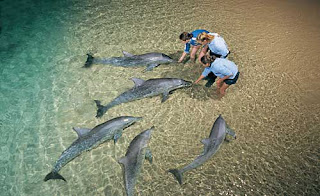At the most westerly point
of the Australian continent, Shark Bay, with its islands and the land
surrounding it, has three exceptional natural features: its vast sea-grass
beds, which are the largest (4,800 km2) and richest in the world; its dugong
(‘sea cow’) population; and its stromatolites (colonies of algae which form
hard, dome-shaped deposits and are among the oldest forms of life on earth).
Shark Bay is also home to five species of endangered mammals.
 At the
most westerly point of the Australian continent, Shark Bay, with its remarkable
coastal scenery and islands, has three exceptional natural features: its vast
seagrass beds, which are the largest (4,800 km2) and most species-rich in the world; its dugong population
(estimated at 11,000); and its stromatolites (colonies of algae that form hard,
dome-shaped deposits and are among the oldest forms of life on Earth).
At the
most westerly point of the Australian continent, Shark Bay, with its remarkable
coastal scenery and islands, has three exceptional natural features: its vast
seagrass beds, which are the largest (4,800 km2) and most species-rich in the world; its dugong population
(estimated at 11,000); and its stromatolites (colonies of algae that form hard,
dome-shaped deposits and are among the oldest forms of life on Earth).
The inland terrestrial landscape
of Shark Bay is predominantly one of low rolling hills interspersed withbirridas inland saltpans. Shark Bay itself is a
large shallow embayment, approximately 13,000 km2 in area
with an average depth of 9m, enclosed by a series of islands. Influx of oceanic
water is through channels: Naturaliste Channel in the north and South Passage
in the south.
The
outstanding feature of the bay is the steep gradient in salinities. It ranges
from oceanic in the northern and western parts of the bay through metahaline to
hypersaline. The salinity gradient has created three biotic zones that have a
marked influence on the distribution of marine organisms within the bay.
For almost 3,000 million
years (i.e. 85% of the history of life) only microbes populated the Earth. The
only macroscopic evidence of their activities is preserved by stromatolites,
which reached their greatest diversity 850 million years ago. The
stromatolites encrypt evidence of the biology of the microbial communities that
created them and the nature of the environments in which they grew. They
dominated the shallow seas and formed extensive reef tracts rivaling those of
modern coral reefs.
 The Shark Bay region is an area of major zoological
importance, primarily due to the isolation habitats on peninsulas and islands
being isolated from the disturbance that has occurred elsewhere. Of the 26
species of endangered Australian mammals, five are found on Bernier and Dorre
Islands. These are the boodie (burrowing bettong), rufous hare-wallaby, banded
hare-wallaby, the Shark Bay mouse and the western barred bandicoot. The Shark
Bay region has a rich avifauna with over 230 species, or 35%, of Australia's
bird species having been recorded. The site is renowned for its marine fauna,
the population of about 11,000 dugong, for example, is one of the largest in
the world. Humpback and southern right whales use the bay as a migratory
staging post. Bottlenose dolphin occur in the bay, and green turtle and
loggerhead turtle nest on the beaches. Large numbers of sharks including bay
whaler, tiger shark and hammerhead are readily observed.
The Shark Bay region is an area of major zoological
importance, primarily due to the isolation habitats on peninsulas and islands
being isolated from the disturbance that has occurred elsewhere. Of the 26
species of endangered Australian mammals, five are found on Bernier and Dorre
Islands. These are the boodie (burrowing bettong), rufous hare-wallaby, banded
hare-wallaby, the Shark Bay mouse and the western barred bandicoot. The Shark
Bay region has a rich avifauna with over 230 species, or 35%, of Australia's
bird species having been recorded. The site is renowned for its marine fauna,
the population of about 11,000 dugong, for example, is one of the largest in
the world. Humpback and southern right whales use the bay as a migratory
staging post. Bottlenose dolphin occur in the bay, and green turtle and
loggerhead turtle nest on the beaches. Large numbers of sharks including bay
whaler, tiger shark and hammerhead are readily observed. 

No comments:
Post a Comment